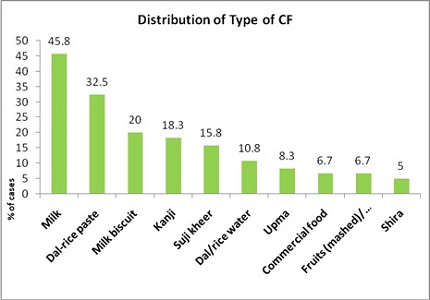Study of complementary feeding practices in mothers of infants aged 6-12 months
Abstract
Introduction: Timely introduction of appropriate and adequate complementary feeds to infants, at the age of 6-9 months is important for the optimal growth of the child. It is essential for child’s mental growth, to prevent under-nutrition and anemia. NFHS-3 data reveals only 55.8% children being introduced to complementary feeds along with continued breastfeeding at age of 6-9 months. Our study was taken to know the profile of various locally prevalent complementary foods, various food beliefs and factors influencing introduction of complementary feeding to infants aged 6-12 months. Materials and Methods: Study was carried out in D.Y. Patil Hospital, where, mothers of 120 infants fulfilling the inclusion criteria were interviewed and data regarding the socio-demographic factors, maternal factors and feeding practices was collected in a structured format. The data was then analyzed using various statistical methods and SPSS software.
Results: The study revealed that incidence of initiating complementary feeding at 6 months is 31.6%. Only 14.28% infants of working mothers received right consistency of complementary feeds. The most common reason for early initiation of complementary feeding was mothers being working while for delay was that baby vomits or gags the complementary food. Animal milk and milk based preparations were commonly used complementary foods.
Conclusion: There is lack of knowledge regarding the ideal complementary feeding practices amongst the mothers. Health workers should educate the mothers regarding continuation of breastfeeding and appropriate timing of introduction of complementary feeds. Mothers need to be taught about the adequate frequency, quantity and appropriate consistency of complementary feeds.
Downloads
References
2.UNICEF. The state of the world's children. Adolescence: Children with disabilities. 2013. [Last retrieved on 2013 Aug 10]. Available from: http://www.unicef.org/sowc2011/
3. Northstone K, Emmett P, Nethersole F; ALSPAC Study Team. Avon Longitudinal Study of Pregnancy and Childhood. The effect of age of introduction to lumpy solids on foods eaten and reported feeding difficulties at 6 and 15 months. J Hum Nutr Diet. 2001 Feb;14(1):43-54. doi: 10.1046/j.1365-277x.2001.00264.x
4. Black RE, Morris SS, Jennifer B. Where and why are 10 million children dying every year? Lancet 2003; 361, No. 9376: 2226-2234.doi: http://dx.doi.org/10.1016/S0140-6736(03)13779-8. [PubMed]
5. Jones G, Steketee RW, Black RE, Bhutta ZA, Morris SS; Bellagio Child Survival Study Group. How many child deaths can we prevent this year? Lancet. 2003 Jul 5;362(9377):65-71. [PubMed]
6. Bhutta ZA, Ahmed T, Black RE, Cousens S, Dewey K, Giugliani E, Haider BA, Kirkwood B, Morris SS, Sachdev HP, Shekar M; Maternal and Child Undernutrition Study Group. What works? Interventions for maternal and child undernutrition and survival. Lancet. 2008 Feb 2;371(9610):417-40. doi: 10.1016/S0140-6736(07)61693-6. [PubMed]
7. National Family Health Survey - 3. International Institute for Population Sciences. Available at: http://www.nfhsindia.org/nfhs3_national_report.html
8. Aggarwal A, Verma S, Faridi M; Dayachand. Complementary feeding--reasons for inappropriateness in timing, quantity and consistency. Indian J Pediatr. 2008 Jan;75(1):49-53. [PubMed]
9. Kumar D, Goel NK, Mittal PC, Misra P. Influence of infant-feeding practices on nutritional status of under-five children. Indian J Pediatr. 2006 May;73(5):417-21. [PubMed]
10. Caetano MC, Ortiz TT, Silva SG, Souza FI, Sarni RO. Complementary feeding: inappropriate practices in infants. J Pediatr (Rio J). 2010 May-Jun;86(3):196-201.doi:10.2223/JPED.1994. Epub 2010 Apr 16. [PubMed]
11.Semahegn, Agumasie, Gezahegn Tesfaye, and Alemayehu Bogale. “Complementary Feeding Practice of Mothers and Associated Factors in Hiwot Fana Specialized Hospital, Eastern Ethiopia.” The Pan African Medical Journal18 (2014): 143. PMC. Web. 27 Nov. 2015.doi: 10.11604/pamj.2014.18.143.3496.
12. Shivani Lodha and Vandana Bharti. Assessment of complementary feeding practices and misconceptions regarding foods in young mothers. IJFANS Vol.2, Iss.3, Jul-Sep 2013. Available at http:/www.ijfans.com/currentissue.html
13. Giugliani R.J Elsa, Victora Cesar Gomes. Complementary feeding. Jornal de Pediatria 2000; Supl.3; S253-263.
14. Sethi V, Kashyap S, Seth V. Effect of nutrition education of mothers on infant feeding practices. Indian J Pediatr. 2003 Jun;70(6):463-6. [PubMed]

Copyright (c) 2016 Author (s). Published by Siddharth Health Research and Social Welfare Society

This work is licensed under a Creative Commons Attribution 4.0 International License.


 OAI - Open Archives Initiative
OAI - Open Archives Initiative


